A spirit level is an indispensable tool for ensuring that surfaces are perfectly horizontal or vertical, making it essential for a wide range of projects, from construction to home improvements. Featuring a vial filled with liquid and a small air bubble, the spirit level indicates whether a surface is level or plumb.
Available in various lengths and styles, from compact versions for tight spaces to longer models for larger projects, spirit levels provide precise measurements for tasks like installing shelves, hanging pictures, or building furniture. Some models even feature multiple vials, allowing you to check both vertical and horizontal surfaces simultaneously.
Whether you’re a professional or a DIY enthusiast, using a spirit level ensures accuracy and precision, helping you achieve a flawless finish every time. It’s a tool every craftsman needs in their toolkit.
Our Top Spirit Level Picks
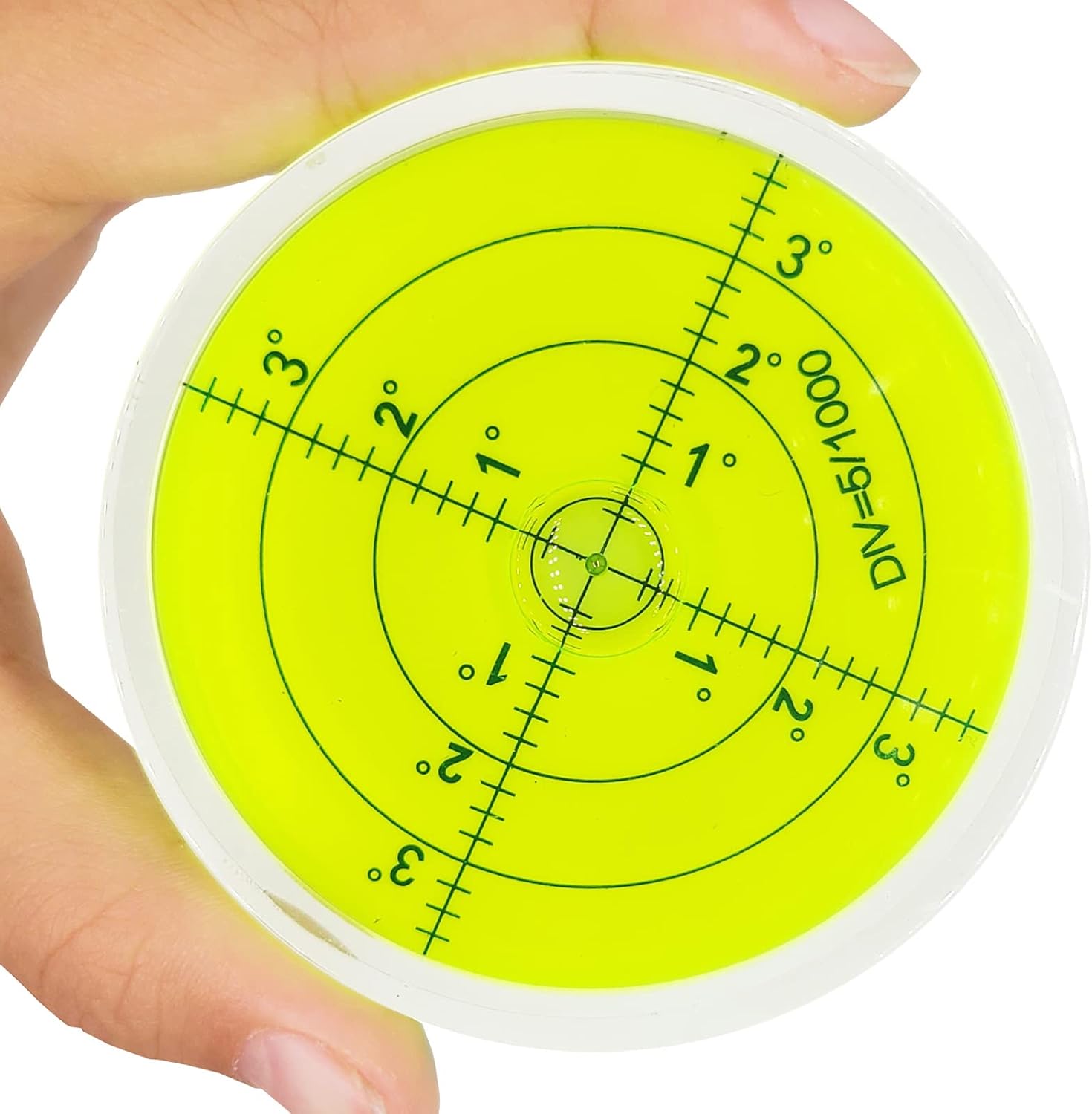
Magnetic Round Bubble Spirit Level
Check on AmazonKey Specs
- Compact size: 2.4 x 0.5 inches (60 x 12 mm)
- Magnetic back for easy attachment to metal surfaces
- Precision marked front panel with measurement grid
- Bubble moves 0.32 inches per 1-degree tilt
- Weighs only 46g for portability
The GEONASSUR Magnetic Round Bubble Spirit Level is a compact and precise tool designed for a wide range of applications, from carpentry to RV maintenance. Its high precision ensures accurate measurements, with the bubble shifting 0.32 inches for every 1-degree tilt. The front panel is clearly marked with a measurement grid for added convenience. Its magnetic back allows it to easily attach to metal surfaces, making it ideal for hands-free use. The compact size and lightweight design (46g) make it portable and perfect for various tasks.
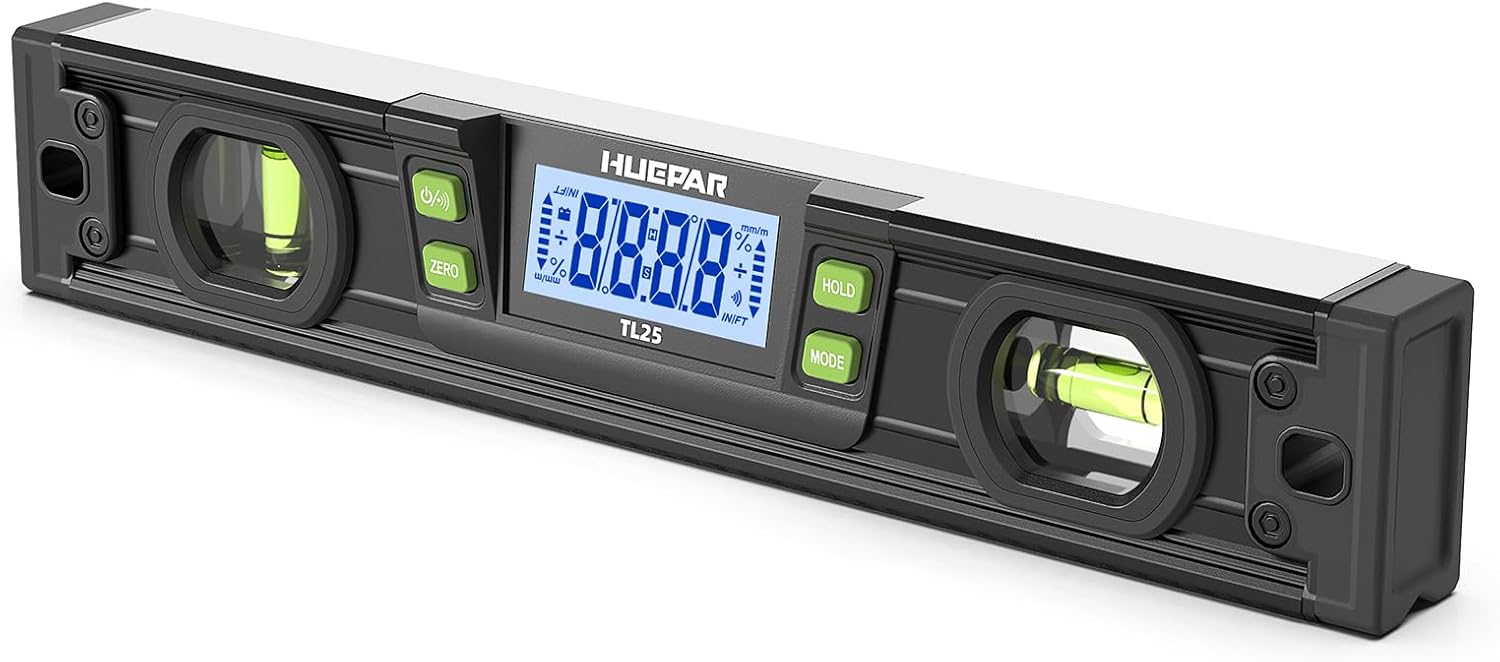
Huepar Professional 10-Inch Digital Torpedo Level
Check on AmazonKey Specs:
- ±0.1° accuracy at 0° and 90°, ±0.2° at other angles
- 8 measurement modes (degree, percentage, mm/m, in/ft)
- Large backlit LCD display for easy readability
- Magnetic V-groove base for secure attachment to metal surfaces
- IP54-rated for waterproof and dustproof protection
The Huepar Professional 10-Inch Digital Torpedo Level is a highly accurate and versatile tool, ideal for precision measurements in woodworking, welding, and construction. With ±0.1° accuracy at 0° and 90°, and ±0.2° at other angles, it ensures reliable results every time. The large backlit LCD display provides clear readability, even in low-light conditions. Its strong magnetic V-groove base allows for hands-free operation on metal surfaces. With 8 measurement modes and a convenient hold function, this level is perfect for various tasks in any environment.
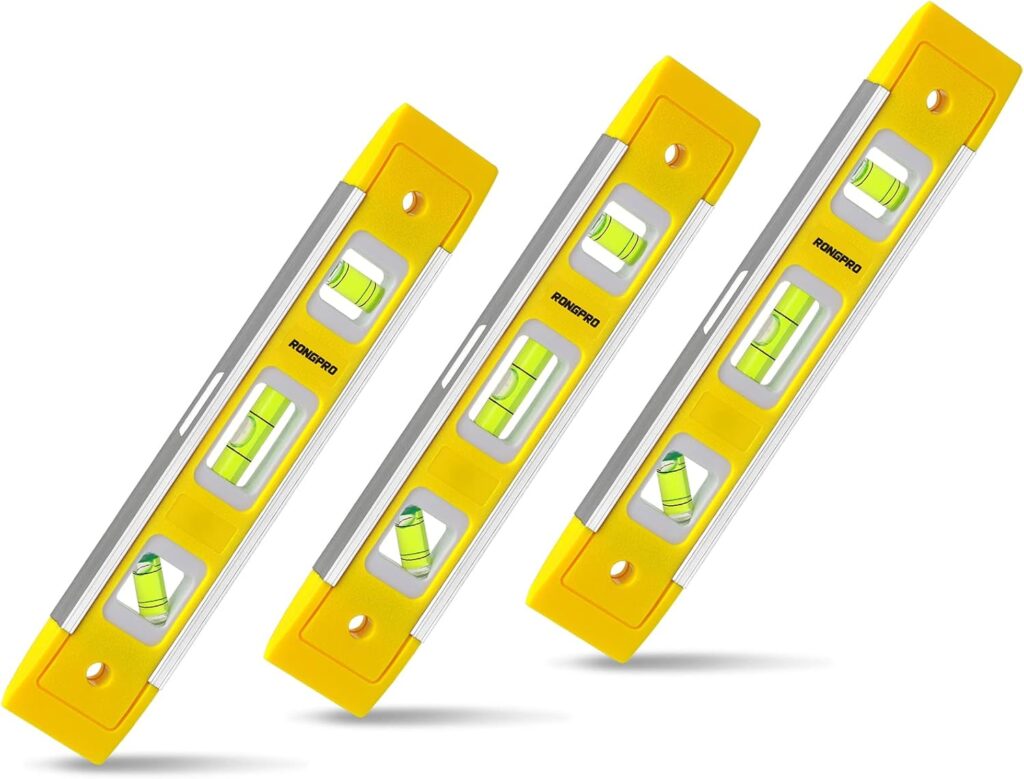
9 Inch Torpedo Level, Magnetic Box Level
Check on AmazonKey Specs:
- 9-inch portable size with 3 leveling bubbles (45°, 90°, 180°)
- Strong magnetic edge for secure attachment
- Accuracy: 0.055° (1.0 mm/1m)
- Viewing window for easy reading from any position
- Shock-resistant and durable for various tasks
The RONGPRO 9-Inch Torpedo Level is a highly portable and efficient tool for accurate measurements. Equipped with three easy-to-read leveling bubbles (45°, 90°, and 180°), it ensures precise readings every time. The strong magnetic edge allows for secure attachment to metal surfaces, eliminating concerns about it slipping or falling during use. Its humanized design includes a viewing window for easy reading from any position and a V-Groove bottom for fitting pipes or conduits. With accuracy up to 0.055° and shock-resistant durability, it’s ideal for woodworking, home improvement, and more.
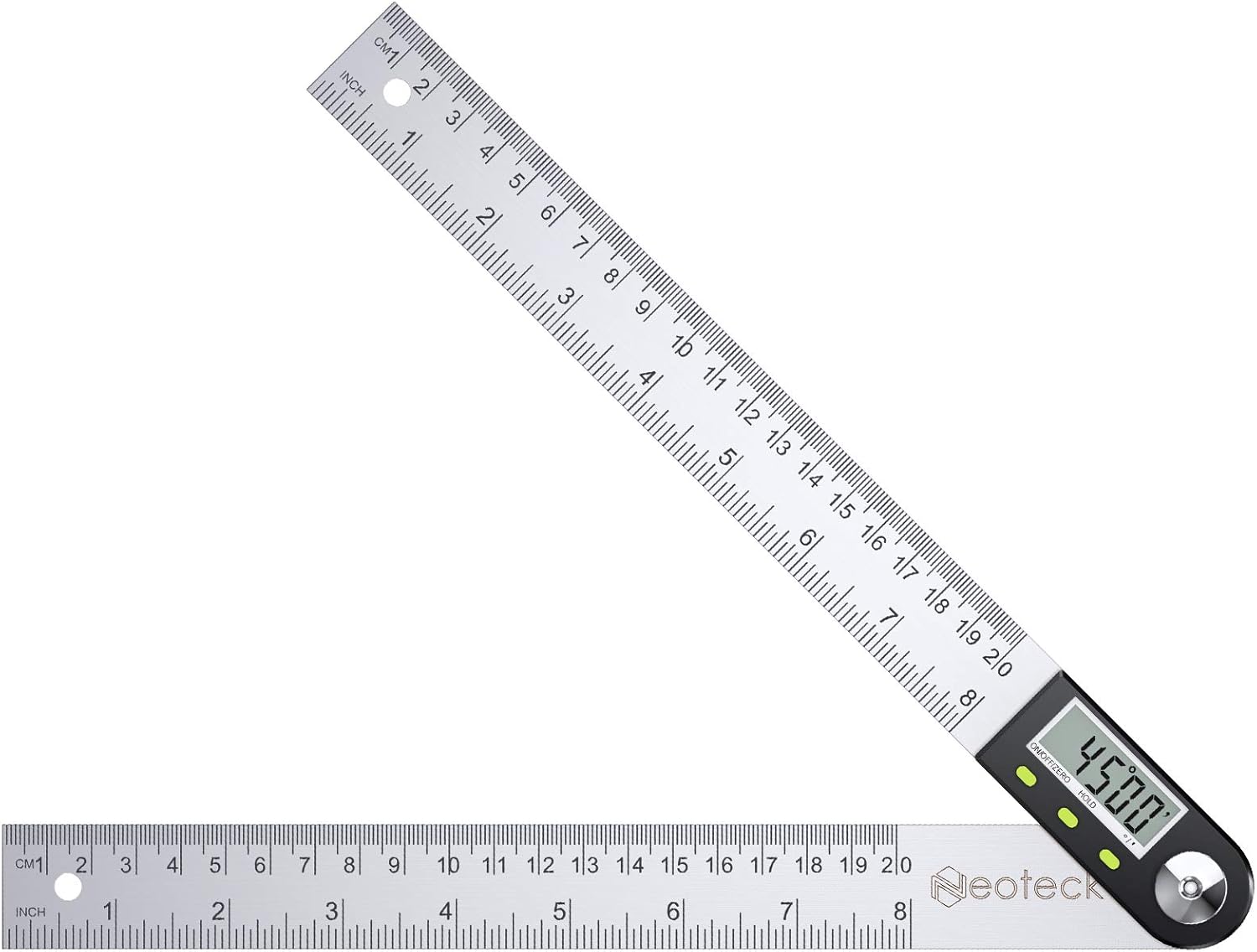
Neoteck Digital Angle Finder Ruler
Check on AmazonKey Specs:
- Accuracy: ±0.3°, Resolution: 0.05°
- Digital LCD display for easy reading
- 8-inch stainless steel ruler with angle sensor
- 360-degree hinge for measuring inside and outside angles
- Includes 3V CR2032 battery
The Neoteck Digital Angle Finder Ruler is an excellent tool for precision angle measurements, ideal for both professionals and DIY enthusiasts. Made from durable stainless steel, it features a digital LCD display for easy readability. With an accuracy of ±0.3° and a resolution of 0.05°, it ensures highly accurate results. The ruler offers both relative and absolute angle measurements and includes a data hold function to lock angle values for convenience. Its 360-degree hinge mechanism allows for versatile inside and outside measurements, making it a must-have tool for woodworking, metalworking, and more.
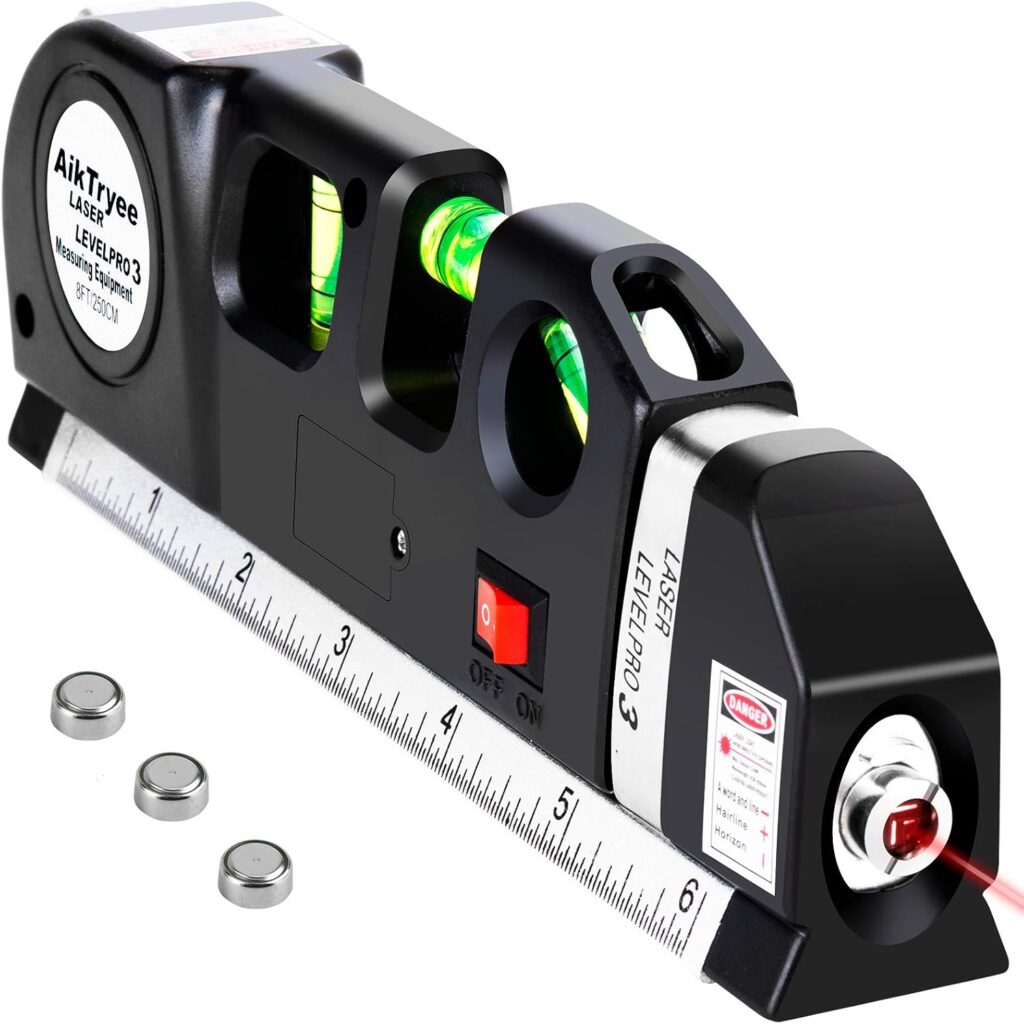
Laser Level Line Tool, Multipurpose Laser Level Kit Standard Cross Line Laser leveler
Check on AmazonKey Specs:
- Multiple laser modes: vertical, horizontal, and cross line
- 3-pronged bubble levels (0°, 90°, 45°)
- 8-foot measuring tape with imperial and metric graduations
- Compact design for easy operation
- Includes imperial and metric measurements with graduations down to 1/32″ and 1mm
The AikTryee Laser Level Line Tool is a versatile and easy-to-use measuring device that ensures precision for various tasks like hanging shelves, cabinets, and picture frames. Designed for indoor use, it offers multiple modes, including vertical, horizontal, and cross laser line settings for different applications. Equipped with a 3-pronged approach—level (0°), plumb (90°), and 45° bubble—this tool ensures accuracy in both horizontal and vertical measurements. It also features an 8-foot measuring tape with imperial and metric graduations, making it an all-in-one solution for precise alignment and measurements.
Importance of Calibrating and Maintaining a Spirit Level
Calibrating and maintaining a spirit level may not sound like the most thrilling task, but trust me, it’s crucial for getting those accurate measurements in your projects. A spirit level is like your trusty sidekick in the world of leveling, ensuring that everything from shelves to picture frames to construction projects is perfectly straight. Without proper calibration and maintenance, your spirit level might lead you astray, resulting in wonky surfaces and misaligned structures. So, let’s dive into the nitty-gritty of why keeping your spirit level in top shape is so important.
When it comes to calibrating and maintaining a spirit level, the process involves ensuring that the tool is accurate and reliable. Calibration helps in verifying that the bubble vial is correctly positioned, providing you with precise readings. Regular maintenance, on the other hand, involves keeping the spirit level clean, checking for any damages, and storing it properly to prevent any issues that could affect its accuracy. By investing a little time in calibrating and maintaining your spirit level, you can save yourself a lot of headaches down the line.
Understanding the Spirit Level
A spirit level, also known as a bubble level or simply a level, is a tool used to determine whether a surface is horizontal (level) or vertical (plumb). It consists of a vial filled with liquid, typically alcohol, with a bubble inside. When the bubble is centered between two marked lines on the vial, the surface is level. There are various types of spirit levels available in the market, including traditional box levels, torpedo levels, and laser levels, each designed for specific applications.
The working principle of a spirit level is based on the concept of the bubble seeking the highest point in the vial due to gravity. When the bubble is centered, it indicates that the surface is level. The vial is mounted in a frame with at least one flat edge, allowing the user to place the level on a surface and adjust it until the bubble is centered for accurate measurements. Spirit levels are essential tools in construction, carpentry, plumbing, and various other industries where precise leveling is required.
Importance of Calibration
Calibration is essential for ensuring the accuracy of a spirit level. Over time, due to regular use or accidental damage, the bubble vial in the spirit level may become misaligned, leading to incorrect readings. Using an uncalibrated spirit level can result in skewed measurements, causing errors in your projects. To avoid inaccuracies and ensure reliable results, regular calibration of your spirit level is necessary.
The consequences of using an uncalibrated spirit level can be significant, especially in tasks that require precise leveling. Imagine installing kitchen cabinets with a slightly tilted spirit level – the end result would be crooked cabinets that don’t align correctly. In construction projects, even a small error in leveling can lead to structural issues and costly rework. The frequency of calibration required for different types of spirit levels may vary based on the level of usage and environmental conditions.
| Type of Spirit Level | Frequency of Calibration |
|———————-|————————-|
| Box Level | Every 6-12 months |
| Torpedo Level | Every 3-6 months |
| Laser Level | Before each use |
Tools Required for Calibration
Calibrating a spirit level requires a few essential tools to ensure accurate results. These tools help in checking the alignment of the bubble vial and making necessary adjustments to achieve precise readings. Here is a list of tools needed for calibrating a spirit level and their functions in the calibration process:
1. **Hex Key**: Used to adjust the screws that control the position of the bubble vial.
2. **Flat Surface**: Provides a stable platform for placing the spirit level during calibration.
3. **Light Source**: Helps in illuminating the bubble vial for better visibility and accuracy.
4. **Reference Level**: A secondary spirit level or a known level surface for comparison.
5. **Cleaning Cloth**: Used to wipe the spirit level clean before calibration to ensure accurate readings.
Having these tools on hand and understanding their functions will make the calibration process smoother and more effective.
Steps to Calibrate a Spirit Level
Calibrating a spirit level involves a series of steps to ensure its accuracy. By following these steps diligently, you can maintain the precision of your spirit level and trust its readings in your projects. Here is a breakdown of the calibration process:
1. **Preparing the Spirit Level for Calibration**: Start by cleaning the spirit level and ensuring that it is free from any debris that could affect the bubble’s movement.
2. **Checking the Accuracy of the Bubble Vial**: Place the spirit level on a flat surface and observe the bubble’s position. If it is not centered, proceed to the next step.
3. **Adjusting the Bubble Vial to Achieve Accuracy**: Use the hex key to adjust the screws on the vial housing until the bubble is perfectly centered between the lines.
4. **Verifying the Calibration Results**: Once you have adjusted the bubble vial, recheck its position on a flat surface and make any final tweaks if necessary to achieve precise leveling.
By following these steps and repeating the calibration process periodically, you can ensure that your spirit level provides accurate measurements for your projects.
# Maintaining Your Spirit Level
Regular maintenance of your spirit level is key to prolonging its lifespan and ensuring consistent accuracy. Proper maintenance involves a few simple tasks that can keep your spirit level in top condition for years to come. Here are some essential maintenance tips for your spirit level:
1. **Cleaning and Storing the Spirit Level Properly**: After each use, wipe down the spirit level with a clean cloth to remove any dirt or debris. Store it in a protective case or a dry, secure location to prevent damage.
2. **Checking for Wear and Tear on the Components**: Inspect the vial, frame, and edges of the spirit level for any signs of damage or wear. Replace any worn-out parts to maintain its accuracy.
3. **Avoiding Extreme Temperatures**: Keep your spirit level away from extreme heat or cold, as temperature fluctuations can affect the liquid in the vial and lead to inaccurate readings.
By incorporating these maintenance practices into your routine, you can ensure that your spirit level remains a reliable tool for your leveling needs.
Common Issues with Spirit Levels
Despite their simplicity, spirit levels can encounter common problems that affect their accuracy. Being aware of these issues and knowing how to address them can help you troubleshoot any discrepancies in your measurements. Here are some common problems with spirit levels and tips for resolving them:
1. **Air Bubbles in the Vial**: If you notice air bubbles trapped in the vial, try tapping the spirit level gently to release them. If the issue persists, it may require professional servicing.
2. **Misaligned Vial**: In case the bubble vial is misaligned, use the hex key to adjust the screws gradually until the bubble centers correctly.
3. **Damaged Frame or Edges**: If the frame or edges of the spirit level are damaged, consider replacing the level to maintain accuracy in your measurements.
By addressing these common issues promptly, you can ensure that your spirit level functions optimally and provides accurate leveling results.
Importance of Leveling Accuracy
Accurate leveling is crucial in various industries and projects where precision is paramount. Whether you are working on a construction site, installing fixtures in your home, or crafting woodworking pieces, having precise leveling ensures the quality and integrity of your work. Here are a few examples of projects where accurate leveling is essential:
1. **Tiling**: Achieving a level surface is crucial when installing tiles to prevent uneven gaps and ensure a professional finish.
2. **Cabinetry**: Proper leveling is necessary for aligning cabinets, shelves, and countertops to create a seamless and functional space.
3. **Framing**: In construction, accurate leveling is vital for framing walls, doors, and windows to ensure structural stability and aesthetic appeal.
By prioritizing leveling accuracy and using a calibrated spirit level, you can elevate the quality of your projects and achieve professional results.
Tips for Achieving Accurate Results
To ensure that you get precise measurements and level surfaces with your spirit level, consider the following tips for achieving accurate results:
1. **Stable Surface**: Always place your spirit level on a stable and flat surface to avoid any discrepancies in the readings.
2. **Proper Technique**: Hold the spirit level steady and avoid applying excessive pressure to the tool, as it can affect the bubble’s movement.
3. **Double-Check Measurements**: Verify your readings by taking multiple measurements and comparing them to ensure consistency and accuracy.
By incorporating these tips into your leveling practices, you can enhance the precision of your work and achieve professional-level results.
Benefits of Proper Calibration and Maintenance
Investing time and effort in calibrating and maintaining your spirit level comes with a range of benefits that can positively impact your projects and workflow. Here are some advantages of proper calibration and maintenance:
1. **Improved Efficiency**: Accurate measurements save time by reducing the need for adjustments and rework, allowing you to complete tasks more efficiently.
2. **Cost Savings**: Avoiding errors due to inaccurate leveling helps in preventing costly mistakes and rework, ultimately saving you money in the long run.
3. **Extended Lifespan**: Regular maintenance and calibration can prolong the lifespan of your spirit level, ensuring its reliability for years to come.
By prioritizing the calibration and maintenance of your spirit level, you can enjoy these benefits and elevate the quality of your work.
Safety Precautions
While calibrating and using a spirit level may seem like a straightforward task, it’s essential to follow safety guidelines to prevent accidents and ensure your well-being. Here are some safety precautions to keep in mind:
1. **Secure Your Workspace**: Clear the area where you will be calibrating the spirit level to avoid tripping hazards and ensure a stable working environment.
2. **Handle with Care**: When adjusting the bubble vial or performing maintenance, handle the spirit level carefully to prevent any damage to the tool.
3. **Wear Protective Gear**: If working in hazardous conditions, such as construction sites, wear appropriate safety gear to protect yourself from potential risks.
By observing these safety precautions, you can maintain a safe working environment and prevent accidents while using your spirit level.
Comparison of Manual and Digital Spirit Levels
When choosing a spirit level for your projects, you may come across manual and digital options, each with its advantages and disadvantages. Understanding the differences between these types of spirit levels can help you select the right tool for your specific needs. Here’s a comparison of manual and digital spirit levels:
**Manual Spirit Levels:**
– **Advantages**: Simple to use, no batteries required, durable construction.
– **Disadvantages**: Limited features, manual calibration needed, may be less precise in some applications.
**Digital Spirit Levels:**
– **Advantages**: Accurate digital readings, additional features like angle measurement, easy to read display.
– **Disadvantages**: Require batteries, may be more fragile, higher cost compared to manual levels.
When deciding between manual and digital spirit levels, consider the nature of your projects, your comfort with technology, and the level of precision required for your work.
Industry Standards for Calibration
In various industries where precise measurements are critical, adhering to industry standards for calibrating spirit levels is essential. These standards ensure consistency and accuracy in leveling practices, contributing to the quality and reliability of the work. Here is an overview of industry guidelines for calibrating spirit levels:
– **Construction Industry**: Construction professionals often follow specific calibration protocols to ensure that structures are built with accurate leveling.
– **Engineering Sector**: Engineers rely on calibrated spirit levels to maintain precision in their designs and measurements.
– **Manufacturing Standards**: Industries manufacturing spirit levels adhere to quality control measures to meet calibration standards for their products.
By complying with industry standards for calibration, you can uphold the integrity of your work and achieve reliable results in your projects.
Case Studies
Real-life examples can illustrate the impact of accurate leveling in various projects and industries. Let’s explore a couple of case studies that highlight the importance of calibration and maintenance of spirit levels:
**Construction Project A:**
– **Issue**: A construction team used an uncalibrated spirit level to install support beams, resulting in uneven surfaces and structural instability.
– **Solution**: After recalibrating their spirit levels, the team realigned the beams accurately, ensuring the stability and safety of the structure.
**Woodworking Project B:**
– **Issue**: A woodworking artisan neglected to maintain their spirit level, leading to inaccuracies in cutting angles and joint alignments.
– **Solution**: By cleaning and calibrating the spirit level, the artisan achieved precise measurements, resulting in seamless woodworking joints and finishes.
These case studies demonstrate how proper calibration and maintenance of spirit levels can make a significant difference in the quality and success of projects.
Conclusion
In conclusion, calibrating and maintaining your spirit level is not just a mundane task – it’s a fundamental aspect of ensuring accuracy and precision in your projects. By understanding the importance of calibration, investing in the right tools, following proper maintenance practices, and prioritizing safety, you can elevate the quality of your work and achieve professional-level results. Remember, a well-calibrated spirit level is your key to straight, level, and flawless outcomes in construction, carpentry, and various other endeavors. So, keep that bubble centered, and let your spirit level guide you to perfection!
FAQ
How often should I calibrate my spirit level?
The frequency of calibration for your spirit level depends on the type of level and how frequently you use it. As a general guideline, manual box levels may require calibration every 6-12 months, torpedo levels every 3-6 months, and laser levels before each use to ensure accurate readings.
Can I use a spirit level for both horizontal and vertical measurements?
Yes, a spirit level can be used for both horizontal (level) and vertical (plumb) measurements. By positioning the level accordingly, you can determine whether a surface is flat or upright with the help of the bubble vial.
What should I do if my spirit level is damaged or shows signs of wear?
If your spirit level is damaged or shows signs of wear, it’s essential to address the issue promptly to maintain its accuracy. Consider replacing any worn-out components, such as the vial or frame, to ensure reliable measurements in your projects.
